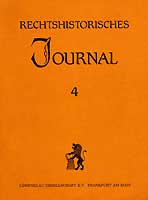The Development of the Modern Doctrine of Necessity: A Comparative Critique
The Development of the Modern Doctrine of Necessity: A Comparative Critique
Author(s): David CohenSubject(s): Law, Constitution, Jurisprudence
Published by: Löwenklau Gesellschaft e.V.
Summary/Abstract: In English jurisprudence the classical conception of necessity focused upon two paradigmatic cases: the plank of Carneades and the theft of food in order to ward off death by starvation. For reasons which I will discuss below, the latter sort of case ceased to be a focus of concern after the seventeenth century, but the former, at least in the Anglo-American world, has continued to preoccupy the jurisprudential imagination. In Germany, however, the contemporary scene is somewhat different, for whereas legal scholars in the period preceding and immediately following the Second World War continued to debate the perennial hypothetical cases of the men on the plank, the alpinist clinging to a rope, the overfilled lifeboat, and so on, contemporary scholars are more likely to discuss more mundane problems like whether or not blood tests may be made on a corpse in order to establish that a pension does not have to be paid to the widow, or under what circumstances a doctor may drive through a red light to reach the scene of an accident. This shift away from the classical paradigm of necessity, only rarely mirrored in real life, to a wide range of practical, recurrent situations in which the doctrine of justificatory necessity is invoked, reflects in German law a constant expansion of the doctrine of justification as a means of regulating conflicts between various social, legal, and political interests and values.
Journal: Rechtshistorisches Journal
- Issue Year: 1985
- Issue No: 04
- Page Range: 215-234
- Page Count: 20
- Language: English
- Content File-PDF

